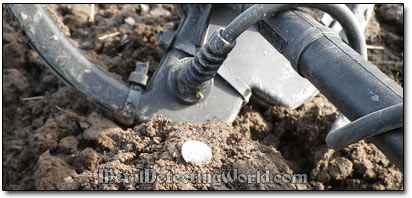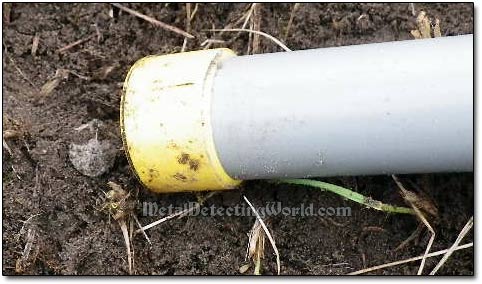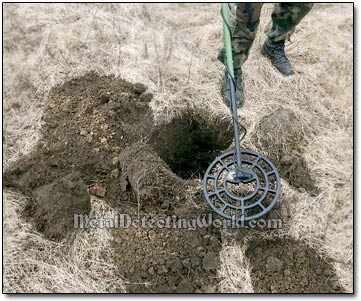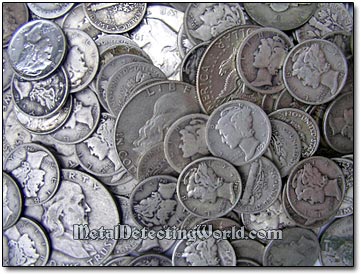What Causes A Loss of a TRUE Coin-Signal During Target Recovery
How To Avoid Abandoning a Good Target After Vain Recovery Attempt, page 2
(...CONTINUED from Previous Page)
The following are other common cases of TRUE SIGNAL disappearance:
1) Along with some loose dirt, a coin has been simply dropped to the hole's bottom and out of the search coil's detecting range when the dirt plug was taken out. Scoop the loose dirt from the hole and scan it in front of the search coil, or spread the dirt on the flat surface or ground cloth and check it with your pinpointer, electronic probe or inline probe. In general, if the ground is dry loose, always gather the dropped out dirt on the bottom of the hole and scan it.

2) A true signal may disappear during improper recovery of a small and thin silver coin (like a hammered coin), or a small gold chain, which had been at shallow depth or on the ground surface prior to being detected. If a thick dirt plug is cut out and laid upside down - its grassy side facing the ground, the target, being now at the bottom, becomes out of detecting range or detector's sensitivity due to the plug's thickness; thus, causing no response.
Turn the dirt plug right up, cut its upper layer (with the grassy surface) 1-2" thin, lay this "slice" flat on the surface, or better - on the ground cloth, and scan it very slowly with a pinpointer, pinpointer probe (attached to your detector) or search coil. Next time you come across another shallow and small target, do not cut a deep dirt plug and do not flip it over.
Locating Tiny Hammered Silver Coin with Vibra Probe 580 Electronic Probe/Pinpointer

3) Inaccurate pinpointing can easily cause disappearance of a real coin signal. Here is the case when after you incorrectly pinpointed the coin, you cut the dirt plug and pulled it out, but the coin was actually left on the hole's sidewall. After you check the plug for a signal and do not get one, you get back to the hole. If you still do not see the coin on the sidewall, you continue to dig deeper and deeper after checking and rechecking the hole for a signal.
Trying to Locate A Vanished Coin Signal

You still do not see the coin so you decide to widen the hole by scraping the sides. Without your knowledge, the coin now drops to the bottom of the hole on its edge in loose dirt. The coin is now about nine inches deep or MORE and beyond the search coil's detecting range. Feeling frustrated, you think about filling the hole and moving on.
If you do not give up easily, you take out the loose dirt, spread it on the flat surface or ground cloth and scan the dirt one last time. There in dirt is a silver coin! This scenario is the most common, and many detectorists have the mistaken belief that they have recovered coins at incredible depths. To avoid this problem and save time, I usually cut the dirt plugs a little bit wider than required. To read more about pinpointing techniques for Concentric and Double-D search coils, please visit my "Pinpointing Targets" page.
4) Use of NON-FERROUS Discrimination can lead to disappearance of a good signal. For example, if pull tabs are rejected, all targets of the same and lower conductivities are rejected as well on a 1-dimensional Discrimination scale. This group of rejected targets may include nickel-alloyed coins such as the US 5-cent pieces - Nickels. If a nickel has been in corrosive soil for a long period of time, it has surely developed a halo just like a rusty nail. Under current Discrimination, the detector is still capable of "seeing" the nickel coin due to its halo effect. As soon as the nickel is dug up, the halo gets destroyed, and the detector does not respond to the coin. Now the only way to find the coin in a pile of excavated dirt is to scan it in All Metal mode.
5) Back in the 1990s - an era of the White's XLT metal detectors, many XLT users could not find coins in their dug holes after detecting them with the XLT's standard 9.5" search coil with an open center. The coin signal would simply disappear due to the 9.5" coil's inability to detect coins that are positioned on the hole's sidewall and close to the surface. To avoid this mishap, cut a wider dirt plug. Today this case has become irrelevant as the metal detector technology has made a huge leap since the 1990s, and the XLT's concentric search coils are becoming almost extinct.
If you come across a strong signal that remains in the ground even after the hole has been dug to unusual depth, most likely this is a large target, either iron or non-ferrous. For example, old pots or buckets with galvanized plating, horse shoes and their halves, axe heads and other iron tools and their fragments usually response with solid and high-pitched (coin-like) tones even if all iron is Discriminated. The non-ferrous targets can be aluminum soda cans, copper drain pipes, aluminum parts of machinery, etc.
Or it could be a MONEY CACHE or COIN HOARD(!) If you detect the site on which the modern junk is not present, you better keep on investigating these signals! Just remember about the Halo Effect and try to recover the targets properly in every case. Halo Effect is also a key factor in constructing your own Test Garden.
Happy Hunting!

Make a Donation
Please help me stay afloat, afford more metal detecting trips with field-tests and experiments to create more informative articles, useful tutorials and helpful guides for detectorists, and maintain this website - the most informative hobby resource on the web! Since I do not have any steady income, any donation matters to me a lot! Thank you kindly!
Clicking on the donate button will take you to a donation page powered by Donorbox and dedicated to my website (MetalDetectingWorld.com). The donation page is PCI-compliant, secured by SSL/TLS, and has a simple form to fill out. Donorbox does not store any card or bank data. Credit card information is encrypted and tokenized by the Stripe payment processor.
This website would not exist without the advertisements we display and your kind donations. If you are unable to support us by viewing our advertisements, please consider making a Donation to ensure the future of this website. By helping me keep this website alive and growing, you will sure help many detectorists around the world as well!
ANNOUNCEMENT:
In January of 2020, I started a one-time fund-raising campaign in attempt to accumulate enough money to buy a simple but reliable 4x4 vehicle. My old 4x4 car (made in 1995) had faithfully served me for 10 years before it eventually went beyond repair last October. Without a 4WD, I will not be able to get to my hunt sites and test-plots hidden in the remote wooded areas inaccessible by a regular car.
Unlucky for me, those sites are the only locations available and suitable for my field-work which results in informative articles you can find on this website. For the past 10 years, my usual field-work has consisted of field-testing the latest metal detectors and accessories, experimenting with some of them, and devising new effective search methods that meet the requirements of the new metal detecting reality.
Before my car died, I managed to finish a couple of interesting detector-testing projects which will be covered in my upcoming articles. But other equally important projects that I was working on were not completed and had to be postponed until the Spring 2020. I hope that this fund-raising campaign will help me get a decent 4x4 by then so that I will be able to resume my work and to write more new articles, tutorials and guides based on data gathered through testing and experimentation.
If you find my website useful and would like it to provide more essential info for you and other detectorists worldwide, please consider chipping in $5, $20, $50 or whatever you can afford to keep MetalDetectingWorld.com growing in 2020. I promise you, it will be money well spent. Thank you.
Donate